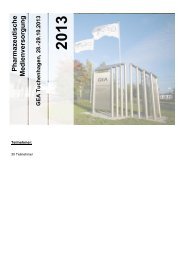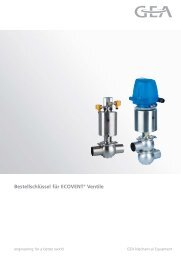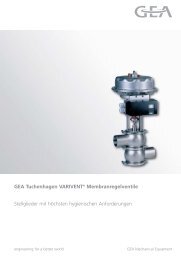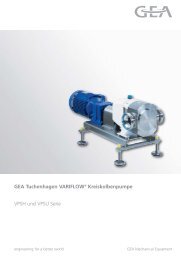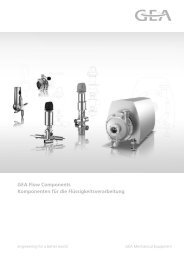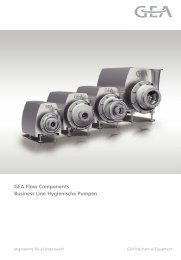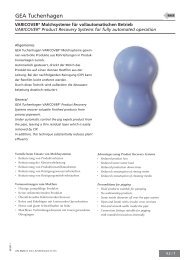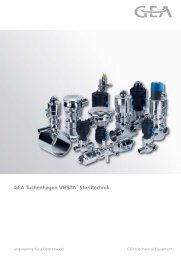Manual for the Design of Pipe Systems and Pumps - GEA ...
Manual for the Design of Pipe Systems and Pumps - GEA ...
Manual for the Design of Pipe Systems and Pumps - GEA ...
Create successful ePaper yourself
Turn your PDF publications into a flip-book with our unique Google optimized e-Paper software.
5.8 Q-H characteristic<br />
diagram<br />
Be<strong>for</strong>e designing a pump, it is important to ascertain <strong>the</strong> characteristic curve <strong>of</strong> <strong>the</strong> plant<br />
that allows you to select <strong>the</strong> right pump by help <strong>of</strong> <strong>the</strong> pump characteristic curve<br />
The operating per<strong>for</strong>mance <strong>of</strong> centrifugal pumps is rarely represented in <strong>the</strong> <strong>for</strong>m <strong>of</strong> tables,<br />
but mainly in <strong>the</strong> <strong>for</strong>m <strong>of</strong> characteristic curves (Fig. 15). These pump characteristic curves are<br />
measured at line machines at constant speed <strong>and</strong> show <strong>the</strong> flow rate (Q in m 3/h) <strong>and</strong> <strong>the</strong> flow<br />
head (liquid column in m) <strong>of</strong> <strong>the</strong> pump. The flow head H <strong>of</strong> a pump is <strong>the</strong> effective mechanical<br />
energy transferred by <strong>the</strong> pump to <strong>the</strong> pumped liquid, as a function <strong>of</strong> <strong>the</strong> weight <strong>for</strong>ce<br />
<strong>of</strong> <strong>the</strong> pumped liquid (in m liquid column). It is independent <strong>of</strong> <strong>the</strong> density (r) <strong>of</strong> <strong>the</strong> pumped<br />
liquid; that means a centrifugal pump transfers liquids regardless <strong>of</strong> <strong>the</strong> density up to <strong>the</strong><br />
same flow head. However, <strong>the</strong> density must be taken into account <strong>for</strong> <strong>the</strong> determination <strong>of</strong><br />
<strong>the</strong> power consumption P <strong>of</strong> a pump.<br />
The actual flow head <strong>of</strong> <strong>the</strong> pump is determined by <strong>the</strong> flow rate H A <strong>of</strong> <strong>the</strong> plant, which<br />
consists <strong>of</strong> <strong>the</strong> following components:<br />
0<br />
HA = Hgeo +<br />
pa ρ<br />
-<br />
x<br />
pe g<br />
+<br />
v 2<br />
a - v 2<br />
e<br />
2g<br />
+ Σ Hv H geo<br />
pa - pe ρ x g<br />
0<br />
v a 2 - v e 2<br />
Σ H v<br />
2g<br />
geodetic flow head = <strong>the</strong> difference in height to overcome between <strong>the</strong> liquid<br />
level <strong>of</strong> <strong>the</strong> suction <strong>and</strong> <strong>the</strong> delivery side<br />
difference <strong>of</strong> pressure heights between liquid level <strong>of</strong> <strong>the</strong> suction <strong>and</strong><br />
delivery side with closed tanks<br />
speed difference (can be neglected in practice)<br />
sum <strong>of</strong> pressure drops (pipe resistances, resistance in fittings <strong>and</strong> <strong>for</strong>med parts in<br />
suction <strong>and</strong> delivery pipes)<br />
20<br />
<strong>GEA</strong> Tuchenhagen




